 If you don't have goals, you are not doing digital analytics. You are doing i am wasting earth's precious oxygenalytics.
If you don't have goals, you are not doing digital analytics. You are doing i am wasting earth's precious oxygenalytics.
Let's back up. Let me start with a story.
[Sidebar] I'm experimenting with sharing short stories via an insightful newsletter. I'd love for you to sign up: The Marketing Analytics Intersect. Thanks! [/Sidebar]
Now, let's get back to the story.
We were brain storming about the next cluster of coolness for Analytics, the conversation quickly went to what Analysts need to look at on a daily, weekly and monthly basis. I started to outline a simple framework that stated that no one should look at anything daily (that should all be automated and run off automated or custom set thresholds – things don't really change materially on a daily basis), weekly should be based on stuff that borders reporting squirrel work and pinches of analysis ninja work, and monthly…. well super analysis ninja stuff. And, then I started to redefine what daily, weekly and monthly even means. From there, it is only a hop, skip and jump to the most deadly question in analytics….
What's the business solving for?
Everything came to a screeching halt. This beautiful daily, weekly, monthly blog post I was drafting in my head to share my excitement with you about thinking analysis differently went poof.
It pains me how critical it is to know what the heck we are solving for with our analytics, and how few people identify goals for their website (mobile or desktop). The reason is simple: If you don't know where you are going, you'll get somewhere and you'll be miserable.
We see this everyday. "Analysts" spewing data out left right and center, after spending so much time tagging and re-tagging and Google Tag Managering. Yet, few Marketers or executives take them seriously (because they don't know what the heck all that means to the business or their own paychecks!).
A vast majority of us out there are data rich, information poor.
: (
Starting today, let's renounce your citizenship in the land of nogloallandia! It sucks to be there.
I can report on pageviews and bounce rates and sessions and all the other lovely metrics we normally obsess about. Or, the foundation of my analysis for this blog can be this:

A much richer understanding about the eight things I'm solving for. Now, all those other metrics suddenly have a purpose and context. I can understand what I'm doing well, what I stink at and start making focused strategic choices about the actions I should take.
Amazing, right?
The number and type of goals we can set up for a business tend to be quite unique. Everyone, even direct competitors, are solving for something different. And, that is how it should be.
While I can't know all the goals you should set (and the economic value you should use for each goal), let me share with you five goals that every business, B2B or B2C, should set up in their analytics practice (in Google Analytics, IBM Analytics, Adobe Analytics, or whatever it is that you are high on right now). Starting today, no excuses for me to log into your Adobe Analytics account and see no goals and associated goal values!
Here's how this post unfolds…
1. "Destination Goal" (Leads, Email Signups, Etc.)
2. "Engagement Goal": Time Spent
3. "Engagement Goal": Pages Viewed
4. "Micro-Outcome Goal": Key Events
5. "Macro-Outcome Goal": Outbound Clicks
Benefits of Identifying Goals and Economic Value
In each case we'll learn in detail how to set up the goal, what type of data might we get from it that will be of value and get tips on what actions we can take.
Ready?
Higher-Order Bits: Location, Pan-Commerce, Re-framing.
Three important things to get going.
Location:
First, you'll need admin privileges for the GA account you have access to in order to create goals and input the goal values. If you do, click on Admin in the top nav in any GA page. Then click on Goals, and then on the red button that reads + New Goal.
You'll see this amazing screen where an entire world of possibilities awaits you!

We are going to use the standard choices above to set-up our Standard and Mandatory Goals for All Businesses (SMGAB!), and we'll also use the Custom option to set up some goals.
Pan-Commerce::
Second, very important thing to note is that you have to set up these, and more, goals regardless of if you have an ecommerce or non-ecommerce website. Most Analysts for ecommerce entities spend all their time with ecommerce data. The conversion rate for most website is around 2%. This implies that all that work, at best, solves for a local maxima – and with a short-term mental model. What about the other 98% that did not convert? Were they all wasted visits? No, of course not. Everyone is not on your website to convert instantly. Analyzing ecommerce conversions PLUS goals means we are going to solve for the global maxima.
Consider Macy's. Yes. They should obsess like crazy about ecommerce conversion rates. If that is all they do, they'll only solve for digital, only last-click and their website would be a constant garishness of BUY NOW WE ARE HAVING A ONE DAY SALE (everyday!). Yes, they would make money, but what's the difference between them and every other joe shomoe? If they solve for ecommerce conversion rates, and goals like requesting their catalog, signing up for their rewards programs, number of new accounts opened, product reviews written, credit card applications, wish-lists created….. I could keep going on and on, but I think you get my point.
Regardless of the type of website you have, you need to have goals set up and for each goal identify the economic value. If you don't, you are risking being prosecuted for criminal behavior!
[If you have an ecommerce website using GA, you should be usingEnhanced Ecommerce . It's a must.]
Re-framing::
Third, if you are a regular reader of this blog, you might have noticed that I don't use the term conversion a lot (unless I'm talking about ecommerce conversion rate). I like using the word outcome. This simple switchroo is to open your mind to all the possibilities that that word represents. I find the word conversions a bit repressive. Hence, analytics framework to represent end-to-end business measurement is called Acquisition – Behavior – Outcomes. Not Acquisition – Behavior – Conversions. You do the latter and the only thing people can imagine is ecommerce conversions. Lameness ensues.
Use the word outcomes.
Each site will have one big outcome that is more important than everything else. I call this the macro-outcome. I refer to other outcomes (think of the Macy's case above) as micro-outcomes.
With those two things out of the way, let's go have some fun.
1. "Destination Goal" (Leads, Email Signups, Etc.)
For ecommerce websites, the macro-outcome will be…. ecommerce conversion rate. Or, revenue or AOV, depending on what you've identified as supreme in your Digital Marketing and Measurement Model.
For numerous other types of websites, the macro-outcome will be a lead of some kind, or a contact us type form. Usually this is connected to the company making money, it might happen on the phone or via email or by someone walking into a physical location. It is imperative that we identify this as close to making money online as we can and set that as a goal. The goal type we'll use is technically called Destination Goal.
Here's the amazing thing, with Google Analytics you don't need to touch the javascript code you've set up to track your site. You can do it all in the Admin section (#freedomfromITteamisawesome). All you need is the destination to use in your goal, and it's quite easy to find.
Let's say you work at www.adobe.com and you've just started to use Google Analytics. Just go to the page where your company has the an important product, follow it to the lead-gen page , and fill out the form with any random information (as there is no in-line error checks):

Hitting the Submit button will take you to the thank you page. Just copy the URL of that page: https://www.adobe.com/products/request-consultation/thankyou.html?form_subtype=Request%20For%20Information
Now, go to the Admin section of GA, click on + New Goal and in the template choose Contact Us in the Inquiry section.
Give the goal a name you'll recognize.
And, here are the details that the Adobe team will fill out in their Google Analytics account…
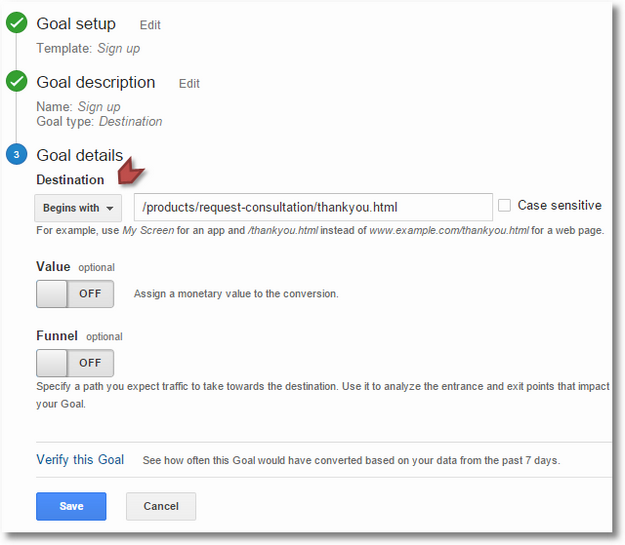
They can simply hit Save and they are done! In a couple of hours, GA will start reporting incredible amounts of goodness around not just how many leads are being submitted, but what traffic sources those leads come from, how long does it take for someone to go from first visit to the site to submitting a lead, what content on the site is most likely to convince someone to submit a lead, and so, so, so much more.
Much better than guessing, right?
There is one item that should not be overlooked. You'll notice the button for Value is turned off. This is where the economic value of each lead goes. How do you get this magical number?
I have an extremely detailed post on the five detailed strategies you can use to calculate economic value. Applying the lesson from there…. The team at Adobe would get help from their CRM system to identify the conversion rate over the last, say, quarter of the digital leads. Furthermore, they will look at the average contract size for those deals. This then allows them to know the likelihood a lead will convert and for how much. It will allow them to identify the goal value of $1,000,000 for each lead submitted.
They'll simply turn the value button to On, and type the new goal value, and hit Save!
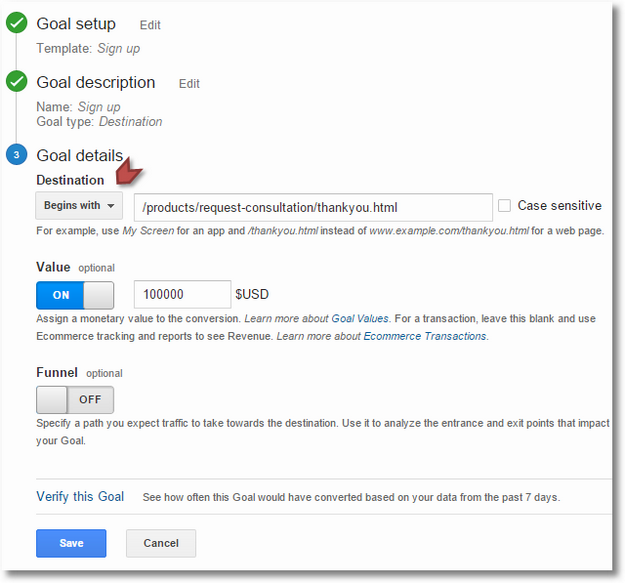
This is not a perfect number, every deal has its own nuance, every deal will be a bit more or bit less etc. Having an average goal value though helps us get to good enough. We could simply use clicks on AdWords ads as success or bounce rates or page views, but everyone of them is lamer than having access to datagasmic metrics like Per Visit Goal Value, Page Value and more. (Lots of detail on this in the last section of this blog post!).
That was not too hard, right?
Every website has this type of a macro-outcome. It is easy to identify, and setting up the goal only takes 90 seconds. You can go see how easy it is to find a destination URL on your website. Or, practice it on IBM, here's the lead-gen page.
Other macro-outcomes you can use, depending on the type of your business, are live chats, phone callback requests, downloads completed, wish-lists created, new accounts opened, and more.
Please ensure that regardless of the type of your website, you've identified a non-ecommerce macro-outcome and are tracking it with a specific goal value identified.
2. "Engagement Goal": Time Spent
As analysts we have an out-sized obsession with Acquisition and with Outcomes. Both are understandable (we have too many Marketers and the company wants money!). It does distress me a bit that we don't spend as much time analyzing Behavior. This the reason I love setting engagement goal types (remember though, don't call the metric Engagement, it's an excuse and not a metric).
Websites of all type should have a goal for a desirable (by the company) time spent on the site. If we have it, we can slice and dice it like crazy (where do these people come from, what content do they like, what internal searches drive more or less time spent, etc. etc.).
Setting a time spent goal is easy. Choose Custom in the goals template. Give it a name (I choose People We Should Love :))….
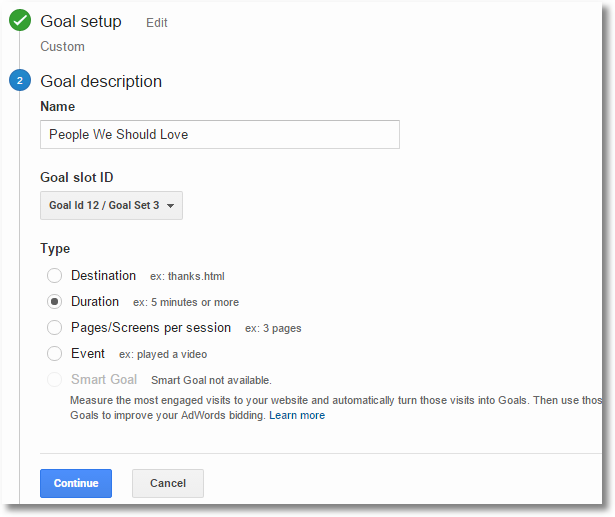
When you click continue, you are going to have to set a duration of time you consider to be desirable.
If you don't want to over think it, just go to the Overview report in Google Analytics and look at the trend for Average Session Duration….

You can do something as simple as choose a "little bit more than the average time". I know that sounds a bit cookoo, remember goals are not set for life and can change. Besides, you got nothing at the moment! :)
Just based on experience, and nothing else, I would simply add 50% more time to the average and use it as a goal. Path of least resistance.
Of course, we can always kick things up a notch. In your Audience folder in GA there is a Behavior sub-folder, and inside that you'll see the Engagement report. Checkout the wonderful distribution you see there for Session Duration….
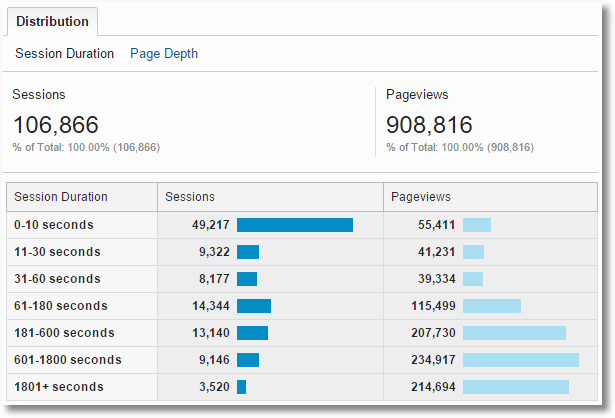
When I'm setting a session duration engagement goal, I like looking for a point of inflection. Notice in my report above, three minutes seems to have some lovely happening. The pageviews ramp up quite a bit, and there is a big cluster of visits that also show that behavior.
This distribution allows me to set a much smarter three minutes as a desirable goal.
Of course, you can kick things up a few more notches. I'll usually create segments for the distributions you see above, and apply them to my Outcomes reports in GA to see if there is really a difference in the outcomes delivered to our business if people stay a longer or shorter amount of time. I always find surprises. Because I don't want to only solve for a local maxima, I also take into consider the impact of time on some of my main micro-outcomes. That helps me set a much smarter duration goal. In the above case, it turned out to be five and half minutes!
So. You have choices in how deep you want to go to get a more informed duration, but remember the most important part is to just get going and have a goal!
Here's the second part of my goal setting window….
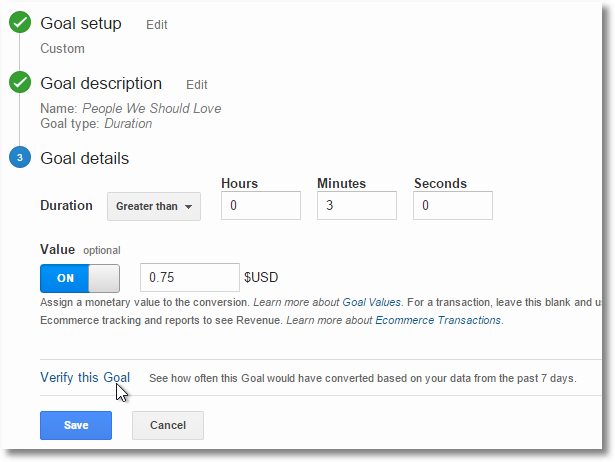
You will notice I have identified an economic value for my duration goal. Remember to checkout my post on how to to calculate economic value.
The lesson applied in the above case was by leveraging AdSense revenue. In your case it could be tied to a number of other things that make you money on your mobile or desktop website.
Now that you have your goal set, you can look at trends and patterns in the data. For example, correlate this goal to others on the website….
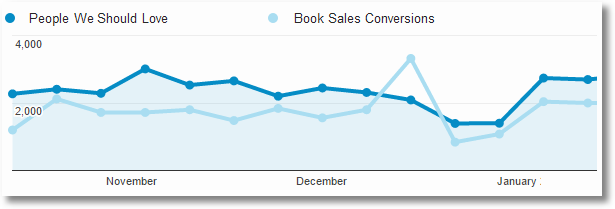
Here's one thing you should be prepared for, if you put some thought into creating a duration goal: When you first plot Sessions and People We Should Love, you are going to cry. It is going to be very small.
The saving grace is, first, that you know and, second, while it won't be a lot of people, they are likely the most precious people. Prepare to wine and dine them.
3. "Engagement Goal": Pages Viewed
The third goal everyone should have is also an engagement goal, this time using pages viewed. While time is particularly important for sites with interactive elements, mobile apps and other such existences, pages is more accurate, and more relevant, for almost all types of sites. (Remember, time is not computed for sessions with just one hit and for the last page viewed in a session.)
You can use the same strategy as above to create a engagement goal based on pages viewed, by looking at the average trends for Pages/Session….

The other two recommendations above for duration also apply in this case.
Once you have identified the value you would like to use, if it it is I think I'll do 15% more than the average pages/session, just go the the Goal Details of this custom goal and type it in….

In so many cases, publishers for example, or this blog, I am very fond of pageviews as a goal to understand how many folks are exhibiting the desirable behavior. I feel that it is a bit more accurate representation of reality. And now that we can to Visitor based segmentation, we can do some really fun stuff once we have this goal set up.
4. "Micro-Outcome Goal": Key Events
This goal type is for those who have just a tiny bit more sophisticated implementation of analytics on their site. Events help us track so many things in a smart and scalable manner. Email sign-ups, comments submitted, video pay buttons clicked, add-to-carts, cross-word tiles moved, and on and on and on. The detailed Event Tracking Guide is a gift, digest it.
One micro-outcome that publishers, ecommerce sites, and I (!) can all track is comments submitted. They are incredibly valuable for some many reasons (loyalty, drive future sales, etc.).
It is pretty simple to set up the goal.
In the template you'll choose Custom and then choose Event…
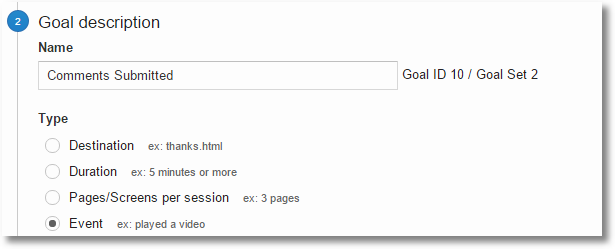
As always the challenge will be, what goes on the next screen where you have to type the Category, Action or Label to use.
You can get this from your even tracking reports in the Behavior folder in Google Analytics….
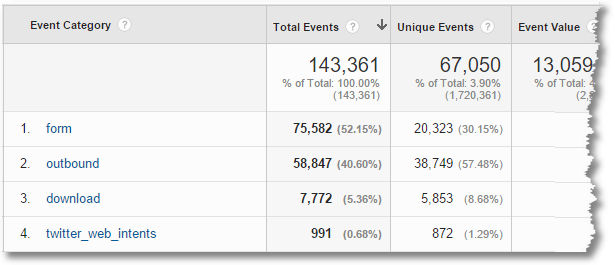
In my case the label I'm using is focus comment. Type that in…. done….
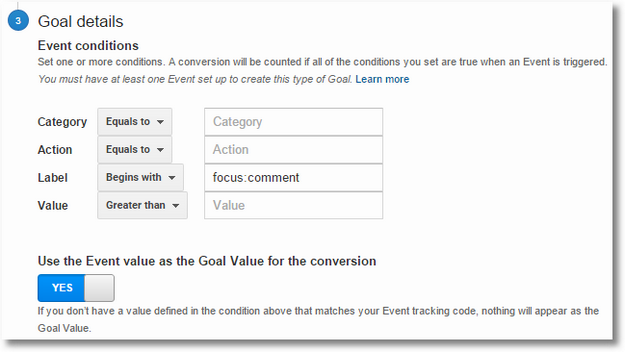
For the events that I'm using I have also identified an Event Value, and I choose to use that as my Goal Value. The approach to calculate the economic value is the same as we did before. Don't let not being able to identify goal values as a barrier to not even setting up the goal (this is crazy important). I do recommend that you do it at some point soon after because the value is simply too big to ignore. Of my five recommended approaches to to calculate economic value, four and five don't even need all that much more work by you. Just do it.
Another event micro-outcome that is a fav of mine for many clients is tracking Live Chats…
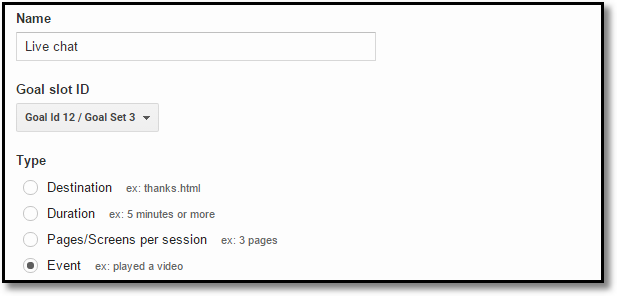
Capturing this allows us to be immensely more clever about informing smarter Acquisition, Behavior and multiple-Outcomes for our businesses. Imagine just one as an example: Are your live chat agents more or less effective than your site by itself at up-selling and cross-selling? Every bone in your body is screaming: AGENTS! My dear, you would be surprised. Especially after you segment the data by Geo.
See what I mean, exciting analyses right?
5. "Macro-Outcome Goal": Outbound Clicks
We are back to macro, and a very good one (for publishers, non-profits, for-profits, and indeed everyone else).
But, first… I've tried really hard in this post not to make things complicated, I so badly want you to know how easy it is to get going, how very easy it is to unleash very smart data analysis using goals. I'm going to continue to do that by showing you the lamest way to track outbound clicks. Don't copy me.Track outbound links using the right way (automated via GTM or using hand-coded events). Do as I say, not as I do. :)
I love tracking outbound clicks. If people just exit our website, we know so little behind why they might have done it. But, if they leave following one of our links, that is either money for our business (from that outbound click directly or from where they are going), increased customer satisfaction, or at the very minimum valuable context related to their departure.
From those possibilities, one that applies to me here on this blog – surely you have similar use cases – are the links on the right (if you are using desktop, else bottom) that you click to exit to learn more about Market Motive (because you want a superb web analytics education and certification!) and my two books. In the simplest possible implementation of this, each time someone clicks on those links, it creates a pageview that it puts in a special folder (which can then be ignored easily in other analysis).
For me to track that click, all I need to do is create a destination goal…
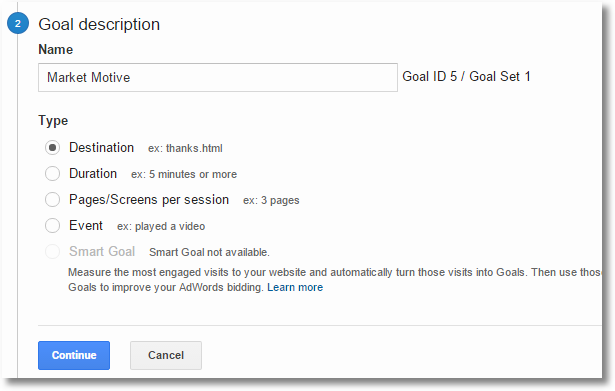
I throw in the url of the pageview that is being collected, add the economic value that I've computed, and we are in business….
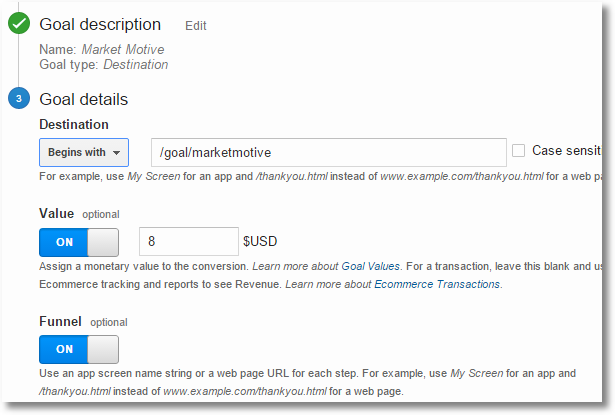
And how do we calculate economic value? You should read that post. :) But, summary…. You can see that those outbound links are tagged, in this case I'm connected to Market Motive and hence I can easily track the clicks and conversions happening online and offline (phone for us). That makes it easy to compute the economic value of each outbound click.
The links for my books that go to Amazon also have tracking parameters, in this case my Amazon affiliate-id. That then allows me to get the clicks, conversions, sales, and commission. I can use that to compute the economic value of every outbound click for my books. (As you all know, 100% of my proceeds from both my books, including affiliate cash, are donated to charity but that does not mean I don't track the success with total and complete passion.)
With my goal configured, I'm ready to step back and watch the money flow out. I mean in. I mean in! :)

Tracking outbound links should be default setting in your GTM account, and if you are not using GTM then leverage the manual firing of events (and use recommendation #4 above to set up your goals).
It is rare that we get to know where people go from our website, grab that info, you will find actionable insights in that data to influence both your Acquisition and Behavior strategies.
While we've covered five different examples of goals that should be standard on every single website on the planet. We've created them using four ways of setting our five goals. In them, it is my sincerest hope that you'll see in them all the permutations and combinations you can create for your own business. Without goals, you are simply messing around with data.
Benefits of Identifying Goals and Economic Value
I wanted to take a moment and share with you all the really cool reports you can get if you create the above five goals (or ones that resemble them for your business).
We all look at Visits and Visitors and our normal clump of metrics. Now. Now you get a lovely line to go with that. You can look at the Visits to your site (light blue) and compare that to the Economic Value (dark blue) created during that time period….

Outcomes, right there, with Acquisition.
In the case above, one does not seem to have anything to do with the other. That is bizarre, right? So, are you getting unqualified traffic? Or, is there something about your Paid strategy that seems to drive something different than your Owned and Earned strategies? Thus far, you would compare those three using impressions, clicks, bounces etc, now, even for non-ecommerce website, you have something material to compare them with, and dig deeper faster.
Because you've created relevant goals, you would of course start that journey by looking at your Owned, Earned and Paid media all in one place. Goal 6 below helps you understand something that you don't have access to by default in your standard reports. And, that last column, Per Session Goal value, is golden.
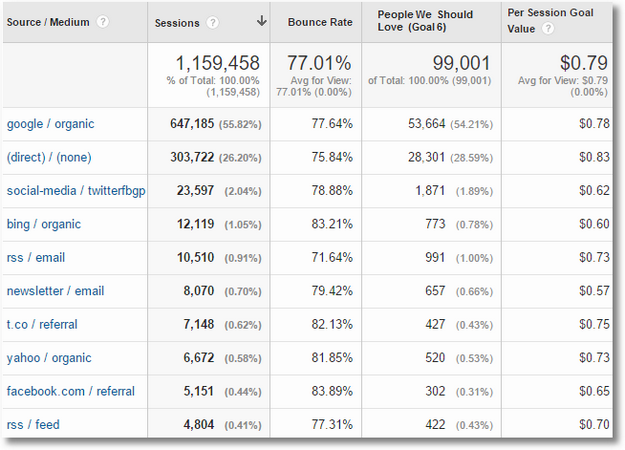
Suddenly you have something to judge the value of every visit to the site delivered from these sources. As you look at the distribution, you'll start to see clues as to where the pain and opportunities might be, giving the time you spend on analysis the most precious commodity of it all: focus.
As you contrast sessions, goal 6 completions, and PSGV, you'll likely want to understand the performance of the content on your site as there is such disparity across sources. This is when you'll need one of my favourite, and I believe under-used, metrics of them all, Page Value.
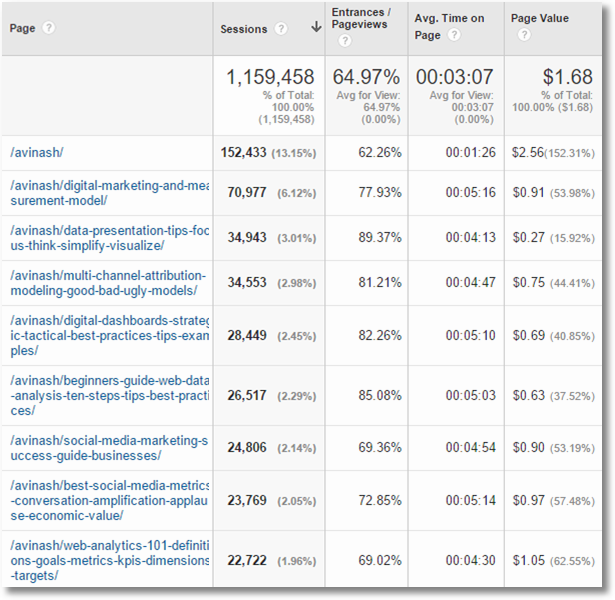
The simplest way to think about Page Value is that it measures how frequently a page appears in a session where goal, or ecommerce, value was delivered to your company. The more frequently the page appears, the postulation is that it must be a page that was helpful to the user. Not completely perfect, but I believe good enough to be of immense help to us all.
You can see above the disparities between each page. No, not using entrances of time, I mean in the Page Value. Finally you have a metric that looks at every bit of content with an eye towards the bottom-line. Thanks you having created goals and added goal values for them.
And if you are not excited about all this really cool stuff, I think I'm going to win you over with this…. Multi-Channel Funnel analysis! Yes! For you, even though you have a non-profit or non-ecommerce website! Pan-session analysis, baby!!
All you need to use the incredibly valuable MCF reports that focus on people and not on visits is…. Goals. :)
Start here, understand how every media channel plays ball with each other…
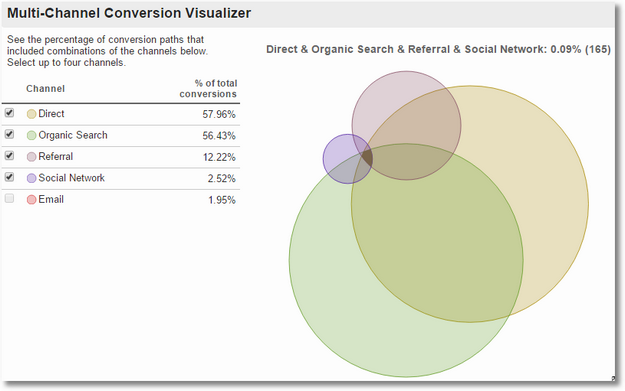
You can see that Direct and Organic Search work in conjunction, and almost all of the Social traffic you have seen before/after having seen them via Direct and a bit from Search. You finally have something to get your company to understand that obsessing about every visit is less productive, it is so much better to focus on every person and their behavior across sessions.
From there, it is a hop-skip-jump to perhaps my favourite standard report in Google Analytics, Assisted Conversions….

I adore this report because it is the only place in GA you'll see pan-session behavior of people across all of your Owned, Earned and Paid media channels in one place. The last column in this report is going to have a deep influence on your company's Acquisition strategy. From this report it is only one more step to multi-channel attribution analysis, and to using this information to change the messaging and sequencing of your messages across channels to deliver relevance to your current and future customers.
And, to think all of this comes from just creating a handful of goals.
That really is all it takes. Be expansive in that quest. For one of my medium-sized B2B clients, here are the goals we identified using my See-Think-Do-Care business framework. Using the framework makes it easier for us to ensure that we are solving for every cluster of intent out there.
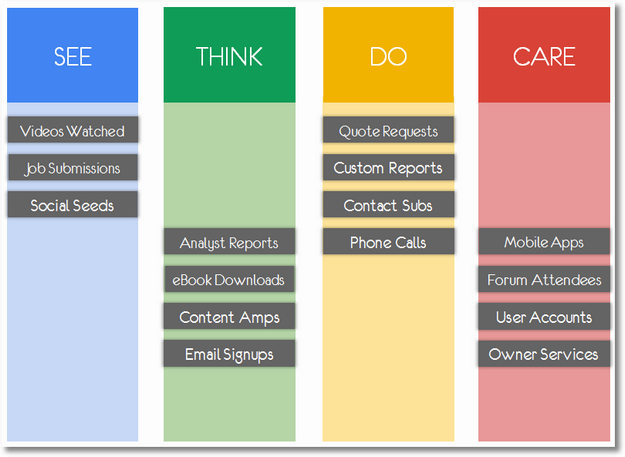
I hope you can see easily how each of the gray box above uses one of the five strategies above to create all of them! For some of them we had to be creative, and it took some work, to identify the economic value. But, in a couple months everything was all set and the company is making smarter decisions. With the framing of See-Think-Do-Care we are solving for the customer, and yet you can see how deeply we are tying everything to the bottom-line. Win – Win.
Oh, one last thing, for the client above, a free gift from the Google Analytics team to us… Automated intelligence alerts when the economic value for each goal falls below the expected range of normal that GA expects….

How cool is it to automatically be alerted that economic values dropped by 22 and 20% respectively? Let me reframe that. How cool is it that GA can tell you that there is big trouble before your boss comes looking for you? Now, you can be prepared with causality answers before she shows up in your office all freaked out.
That my dear is how you get a raise. By having goals. :)
As always, it is your turn now.
Do you have goals set up for your website? Are they strategic or tactical? Do you have them clustered using See-Think-Do-Care? Would you please share some of your favourite goals? Do you have examples of how using goals transformed your ability to understand performance? Do all your goals have clearly identified economic values? If you've struggled with computing value for a particular goal, what was the goal? Any tips on how the rest of us can better at computing economic value?
Your kind guidance, feedback, tips, critique and examples will help all of us in the community win a little more, please share via comments below.
Thank you.





 Via
Via 














Awesome article Avinash!
But I still don't know how you compute economic value for "Engagement Goals". How do you know the economic value for users who (for example) spend more than 5 min on your site and whether this doesn't interfere with other economic goal values? :)
Ivan: I'm glad you are intrigued about how to do this, but I'm sorry that the guidance was not precise enough for you. The best place to start on this topic is here:
https://www.kaushik.net/avinash/web-analytics-tips-identify-website-goal-values/
You can create cohorts of visitors with different time periods and see what the impact on revenue or economic value. There might be other possibilities as well (work with a GACP, they can help, list: http://www.bit.ly/gaac).
To your point about "interfering with other economic values", GA will consider multiple completed goals in one session (though only one will be counted if the same goal is met multipel times).
Avinash.
Dear Avinash, thank you for your answer, this is an issue that’s been bugging me for quite a while, but I still can’t seem to find a clear solution. I will follow your advice and also discuss it with colleagues at GACP program.
Thanx!
Ivan
Also Ivan, tracking engagement goals is important if you're doing paid search. You can define what behaviors and engagement metrics and use this to qualify an audience for remarketing (and negative remarketing).
Excellent! Thanks Avinash, for the in-depth analysis and tips. :)
People, who are following your screenshot to set "Destination Goal" might get confused with "Equals to" Destination URL, because that Thank You Page has post-fix "?form_subtype=Request%20For%20Information" as well.
Just a little thing, but it might not record goals. Instead, Destination field should have "Begins with" for the above example.
Thanks.
Aakar: An excellent point. Depending on the GA configuration they might be fine with Equals. But, just to be safe it might be better to follow your advice.
I'll make the change in the article as well.
Avinash.
Awesome as always Avinash, thank you.
The topic is a complex one, but you've managed to make it very simple with guidance on how to come up with thresholds and values for goals.
Hope you are well.
Keep a clear view and zero in on your goal. Just take one thing at a time.
Thanks for this article!
Man, you're killing me ;-)
Just how much do we still have to learn?
Walter: Ha, ha!
There is always a room for a little more learning, a little more coolness. : )
Stay hungry, stay foolish.
-Avinash.
Right? You start to think you're getting a grasp of things, and Avinash goes and drops another knowledge bomb on you.
Not that I mind, of course. Bombs away! :)
This is one of the best posts I've read in a long time.
I have been bashing my brains on how to do this,
I've added it to my evernote.
Thank you!
James Hughes
That first paragraph is a thing of beauty.
Great article.
"In your Acquisition folder in GA there is a Behavior report. Checkout the wonderful distribution you see there for Session Duration…"
I must be blind because I cannot locate this at all. Thanks in advance ;)
Rick: This is the trouble with writing posts when I'm 36,000 feet up in the air with no internet access!
One small bit is missing in my description above.
Follow this trail: Audience > Behavior > Engagement
I hope this helps.
Avinash.
As always, your posts are very inspiring, thanks for sharing your knowledge!
I found the advice on how to go about finding the goal values for #2 and #4 to be quite valuable.
Amazing post!
Is it weird to love Avinash's clear articulation of these thoughts so much? You are like the Jeeves of analytics. Let's hope we are a bit brighter than Bertie Wooster.
And seriously, people, go back to 2011 and read this so you understand:
https://www.kaushik.net/avinash/web-analytics-tips-identify-website-goal-values/
If you have to, go with faith-based info from your friends in finance. As AK says in that post, "People in Finance are your much underappreciated BFFs."
Susan: As a massive P. G. Wodehouse fan, I wish I could share how delighted I was about your reference to Bertie Wooster!
Thank you.
Avinash.
Thanks so much for the article. It popped up in my feed at the exact moment I needed it!
Question though, any tips on creating destination goals for pages that are dynamic (using AJAX or some other code thing I don't fully understand)?
The landing page for the successful completion appears the same after submission.
Jennifer: The best strategy is to use Events, especially for dynamic environments.
If you are using Google Tag Manager it is less complex, though you will need a developer for these things to do the right bits in the dynamic code at your end.
If the landing page after the submission is the same, you can certainly do that today (same process as I used for the Adobe example in #1).
Avinash.
This is a lot of great value packed into a single blog post!
I have been meaning to set up more goals for my blog and you have just convinced me to just get it done. Your explanations are clear and easy to follow.
Thanks for sharing this!
Hey Avinash !
Thanks a lot for this great blog post, you rock !
Quick question : I also find the Assisted Conversions report super helpful. However, it only displays conversions altogether, right ? Do you know if there is a way to get that report segemented by goal ?
Thanks a lot !
Camille: Luckily you can actually get it for any goal that you want.
On the top left of the report, you'll see button called All, on top of it is the word Conversion. Click on the All button and it will show you all your goals listed (and they'll likely all be selected). Just uncheck all the ones you don't want, and boom!
It is an excellent idea to look at each goal by itself. You will see the button above in all the Multi-Channel Funnel reports.
Avinash.
Excellent article, Avinash! It's only a month I have started working on Digital Analytics, but I have already read countless of your articles :-) Thank you!
May I add to Ivan's question about interference? I am worried about double counting the economic value of correlated outcomes. Take the "Pages Viewed" & "Time Spent" engagement goals. People who spend a lot of time on the website are also likely to view many pages. Because of this overlap, assigning an economic value to both goals might lead to double counting the economic value of these users.
Similarly, estimating the economic value of micro-outcomes based on that of macro-outcomes might lead to double counting. Say for example that you have a "more than 3 minute spent on the website" micro-outcome, and you estimate its value based on how likely these people made a purchase on the website. Then, if purchases are also tracked on Analytics, you will be counting the same economic value twice: first, you spread it over all the people that spend more than 3 minutes on your website, then you count it again when one of them makes a purchase.
Ideally, Analytics could implement an algorithm to subtract the "intersection value" between different outcomes… but maybe it is not such a big deal, and this is just my background as a fastidious physicist coming back to haunt me :-D
Guido: Let me split my answer into two pieces.
You would not have both Duration and Pageview as goals. It would be an unnecessary complication. You would pick one, and almost all of the time you should pick Pages and not Time (I mentioned the reasons in the post above).
Ivan and you have made an excellent point. Perhaps it will help to split the understanding into two pieces. Revenue is what you make that is hard cash, think of it as the short-term view of success. All the other Micro-Outcomes will convert into some time of long-term revenue, but it is deliberately that I call it Economic Value. The hope is to measure the value you don't realize in the short-term as revenue, but recognize that the outcome delivered is valuable to the business. It is simply a way of quantifying those visits/visitors and separating them for those that add no value at all.
If it helps, you report some variation of Revenue to the government (if for no other reason than your legal obligations). You will not report Economic Value to anyone except internally, and only to make smarter decisions about "non-short-term-revenue, yet long-term value" visits/visitors.
-Avinash.
Thank you for your clear answer, Avinash!
I think I understand what you mean: we should consider micro-outcomes and macro-conversions as two separate buckets: the former is an indicator of (potential) future revenue, while the latter is more about immediate $$$.
I now realise that you have already answered similar questions here:
https://www.kaushik.net/avinash/web-analytics-tips-identify-website-goal-values/
I should have read that article before commenting :-P
Validation! Thank you!
My clients don't like to share the data that would help define the value of a lead – they see it as private and protected information. So I tried to do the next best thing, I listed all of the defined Outcomes for their site and assigned each a point value.
The most valuable action available on-site is to request an appointment so that was scored as 100. A contact request form submitted after a survey converts into an appointment 80% of the time – so 80 points… all the way through 16 measured Outcomes.
While the 'points' I use are disconnected from cash value, the process has still allowed us to bring tremendous focus on how people interact with the client's site over time. That's a game changer – it shifts focus from value per session to value per relationship (as suggested in your previous article http://goo.gl/g0GcSc)
Stu: I am completely with you, it is an extremely smart strategy.
I have a tweak on this in my article on how to compute economic value, I call it using "relative goal values" (#4 in the article). The reason I propose considering that (works like yours) is that you will get all the Benefits listed in the post.
That, I'm confident will cause your client to get over the secrecy bits. In aggregate you'll hardly have info to destroy them (should you decide, and you won't, do to something crazy). The benefit is too huge.
Thank you for sharing your approach and inspiring us all.
Avinash.
Avinash, thanks for the article, great way of keeping it easy.
When it comes to engagement, what is your view on Smart Goals?
Thank you.
David: Smart Goals are valuables in the context that most businesses have nothing. They can allow you to optimize AdWords ROI based on something of value rather than just clicks etc.
My recommendation is to have your own goals (as outlined with ideas in this post). Pass them into AdWords, you know exactly what you are solving for.
I do find it to be of value to look at what settings Smart Goals automatically comes up with. The automated algorithm sometimes digs out things that can be quite interesting to consider as I set my outcomes strategy.
Avinash.
It pains me to see clients coming in that spend $8 mil on PPC/month, and God knows how much on SEO, etc., and have a whole team of Data Scientists, and have Google Analytics Premium, and do not have ANY kind of goals configured.
What ?!?
And when you inquire about it you get: We don't have goals because our primary goal is incremental traffic. Just focus on that!
Argh … kill me now please!
But worry not… I'll win this battle!
Hi Avinash,
I found this article to be very intriguing. As a novice to digital analytics, I was unaware that goal setting was even possible. My B2C client is a local veterinary hospital, they mostly use their website for basic marketing and education on exotic pet care.
Do you think adopting engagement goals would be beneficial for them?
Thanks very much!
Avinash,
Thank you for another fantastic article! I'd appreciate your advice about measuring goal values and campaign costs.
Our B2B site's primary goal is "contact me" form submissions. We have a very long sales cycle, and no consensus on how to calculate the true economic value of those requests. My plan was to use relative values for our various GA goals. HOWEVER, I just discovered GA will let me upload actual cost data for our various marketing campaigns (sponsored content, ads on industry websites, etc.)
1. Is using actual $s for our costs and metaphorical $s for our goal values as terrible of an idea as it sounds?
2. What are the downsides of uploading actual cost data, but NOT assigning any goal values? (I work with a lot of accountants. Convincing them to use a set of "imaginary" numbers when we have a set of "real" numbers is going to be a hard sell.)
Thanks for your help!
Jessica: OMG, if you have actual cost data, use it! You will be in the 1% that are doing this the right way. :)
I'm confused about the second question. You simply need to use goal values. If you have actual ones, definitely use them. If you don't have the actual precise number, use the techniques in the post to come up with the best possible estimate. (Not, imaginary.)
Finally, re accountants, remember nothing in GA is ever reported to the SEC (or God save you!). You are simply trying to make smarter decisions about your marketing and user experience. The accountants still hold the keys to report your earnings etc., as it should be.
Avinash.
Avinash,
Thank you for the insight. It's very much appreciated!
(Re: the second question. By "imaginary," I just meant our managers [who all have accounting backgrounds] would view anything other than exhaustively calculated goal values as inaccurate metaphors that might lead us to draw incorrect conclusions about the true value of our various campaigns….etc. etc. But that's my battle. :) )
Thank you again for the response. Your articles have been so incredibly valuable to me over the past few years. They have helped me transition from a number-phobic copywriter to the data-vangelist in my department.
Hi Avinash. Great article as usual. :)
Question for you: I work on the supply-side of an online marketplace, and my "marketing" efforts are trying to get supply-side user acquisition, and individual supplier performance and efficiency all up and to the right.
I've been a devout follower of tracking user behavior for a while (why do suppliers sign up for our marketplace? what do they do when they get into the community? who does the most/least in our platform and why?); but I've always struggled to attach an economic value to any individual supplier. To wit: how to calculate the marginal value of an individual supplier in a community of suppliers, not knowing whether I'm adding total supply or if I'm just adding a redundant supplier who's contributions would've been taken by another supplier already in the community.
Summary of question: tips on assessing economic value in a supply-side community? How can we attribute new marginal success versus just cannibalization?
Erik: It is difficult, but, as you might have suspected, not impossible.
I tend to use controlled experiments to measure incrementality. There are many different ways to accomplish this, I'd covered this topic in this post:
~ Measuring Incrementality: Controlled Experiments to the Rescue!
I also covered the concept in my post on measuring success on Facebook, see Lesson 2 in this post:
~ Facebook Advertising / Marketing: Best Metrics, ROI, Business Value
Hire a smart consultant, they'll be delighted to help you (some are here: http://www.bit.ly/gaac).
Avinash.
You're the man. I read your economic value post and got great insights. I've now defined several goals in GA and assigned relative values, which are best guesses but still accurate in relation to each other. These should serve me until I can run an incremental experiment and get the real numbers.
Goals are essential in getting a task done correctly. Without a goal, you have no direction and no motivation to achieve the end means.
I completely agree with the article and all of the specific goals for analyzing information are very common efficient strategies to have.
Thank you so much for this detailed (and patient voiced) explanation.
I try to walk through these steps with people and it can make them glaze right over! But you've added just the right language and approach to make it seem tangible, and more importantly, do-able!
Really think this is the guide that many have been seeking!
Great post, as usual.
Question: seeing as we are talking about goal completions, I'm working on solving an issue of trying to come up with a "conversion rate" for a group of purchasers who routinely convert numerous times per visit. They are going through the funnel multiple times, and I cant think of a way to show a conversion rate side-by-side with the other customer segments and relate them at all. Any ideas?
Thanks!
-D
Dave: There is likely more complexity in your use case, and getting advice from a blogger is something I don't recommend! :) Get a GACP, they can understand the use case better and give you very specific advised. Here's a list: http://www.bit.ly/gaac
But. Two things to know. For ecommerce, all the conversions will get recorded. For goals, only one unique completion is recorded per session.
Avinash.
Incredible and very Useful Blog Post Avinash.
Thanks for sharing it with us. :)
Dear Avinash,
Thanks for the blog.
You have always inspired me to push hard and deliver that extra stuffing of creative solutions to my clients.
And this post again is a brilliant post. Enjoyed it thoroughly.
Saurabh Mhase
" Google Tag Managering" :-)
Very informative and well written. I'm especially appreciative of the very specific examples that I can essentially copy/paste into my own implementations.
Thanks so much for this wonderful post.
Thanks for sharing.
I never thought of setting these goals in regard to my analytics. Definitely need to look into this again!
Avinash, Wow it just keeps getting better!
I recently signed up for the Market Motive Web Analytics course taught by you and its the most freaking awesome course I have ever taken in my life!
Anyone doing web analytics should take this course, I honestly think it should be mandatory before you dive into the world of web analytics as it teaches you how to structure your web analytics analysis and not get lost in the noise.
Thanks for all you do!! Wish you posted daily!!
Great post, since i am new blogger.
This article clearly explained the uses of google analytics.. Thanks a lot..
Great article!
When looking at data in general, is it better to be setting up segments by session or by user?
What about it trying to line everything up with data from AdWords; sessions or users?
NK: It really depends on the context related to why you are setting up the segments.
Segments that focus on User behavior or behavior of a User in a single session can both be of value. Ditto for Adwords.
Here's a blog post with more on this topic, and many examples:
~ Google Analytics Visitor Segmentation: Users, Sequences, Cohorts!
Avinash.
Hi Avinash, yesterday I added 4 goals in my GA account and I can't tell how much awesome am I feeling. Nothing beats the feeling of seeing goal value in your GA account. I am so much excited. I have some problems with creating 2 goals. Can you help me with this ?
1.Whenever someone subscribes to my blog, it doesn't show any thank you page and thank you message just appear on my screen. So, I am creating an Event Tracking in GTM for form submission. And I need to include the form Id. but my form Id keeps changing again and again. The problem is my id is not constant. The beginning few characters are constant but the later characters are keep changing.
Like – 1. yui_3_17_2_1_1472837316033_380
2. yui_3_17_2_1_1472833812034_735
3. yui_3_17_2_1_1472838339489_348
4. yui_3_17_2_1_1472838380065_734 and so on
what I need to do to configure it on GTM ?
2. I am trying to create a file download goal. As someone clicks on a button and link to download a file, it takes a user to my google drive to download it.
The Url is – https://drive.google.com/drive/xxxxxxx
I am using a custom destination goal to create it. And using – Begins with – /drive/
but it's not working. Can you tell me, how to correct it ?
Thanks for reading this message. Hope you have a great day.
with Regards,
Bhola
Thanks for posting this detailed information about About Goals And Goal Values!
I'm off to recreate these in our accounts.